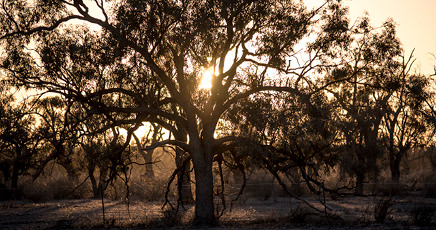STORY
From the smallest of insects and spiders, to birds, reptiles, mammals and frogs, each class was given the responsibility to learn as much as they could about a native animal. They had to focus on the type of habitat their chosen animals needed to survive. With the changes in their local area from a rural to an urban environment, they wanted to understand how they could help the animals by creating native habitats to help with their survival.
Suyin could see how her friends were starting to understand that they are surrounded by wildlife, not only at school, but in all areas around them, both urban and rural. It was so wonderful to see everyone get excited to help, particularly her friends that live across the valley. They couldn’t wait to start work on creating habitats to encourage more wildlife to move in and call their area home.

Creating a wildlife habitat can provide a home for a variety of local wildlife from the smallest insects and spiders to birds, reptiles, mammals and frogs. These habitats can provide a sanctuary for species that have been displaced through urbanisation, as built structures replace natural areas.
The Vision activity determined the needs of your local species to survive. This information will be used to design the perfect habitat to support these species in your local area.
This learning activity is the third part of a sequence of 5 individual learning activities focused on creating a wildlife habitat. The order of these learning activities are: research, vision, design, planting and monitoring and care.
For children to:
- design a wildlife habitat for local species
- understand the relationships between urban, rural and natural habitats
- aim to create wildlife corridors to enable animals to move between habitats
- enjoy being active and productive outdoors and build their social and teamwork skills
- understand the steps involved in creating wildlife habitats.
This activity can be undertaken any time of the year.
Introduction
Creating a wildlife habitat helps you create an environment that will ensure the survival of local animal species. The design phase is essential to ensure your wildlife habitat will meet the needs of the native animals that already call your local area home, and encourage more species to live in your new wildlife habitat.
*Time allocation will be dependent on site selection and travel time. Additional time may be spent in consultation with your local Landcare group, council, or Indigenous plant nursery.
Checklist
Instructions
STEP 1
Mapping your local area
Take a moment to introduce the topic of habitat design to the children.
You have learnt about local animals and plants and their shelter needs. It is important that you determine the best location to build your wildlife habitat to increase biodiversity and to create a safe environment for everyone.
Using the Design Activity Sheet, create a map of built environments in your local area with Google Maps in satellite view. Draw your map using the legend/keys to highlight residential, industrial, natural areas/parklands and your school.
STEP 2
Using what you’ve got
There are many existing features in your local area that can be incorporated into your wildlife habitat design, including established trees, rainwater tanks and ponds. Make sustainable choices by using what you’ve already got.
Walk around the location where you want to establish your wildlife habitat and use the checklist in the Activity Sheet, along with the built environments map to identify these existing features.
STEP 3
Climate matters
Start a discussion about climate zones using the Bureau of Meteorology climate zone map.
Explain that climate zones are regions that are defined by their temperature and rainfall. The climate zone you live in, impacts the type of plants that will grow in your local area.
Determine your climate zone using the map.
Consider your climate zone and use your plant list from the vision activity along with associated field guides and nursery lists to select species that will flower at different times of year. This will provide food and pollination sources all year round.
STEP 4
Wildlife habitat design
Reflect on the information you have collected on your map and plant list to help guide your wildlife habitat design. Use The Habitat Network resources to help choose the best position for your plants.
Draw your wildlife habitat design in the Activity Sheet, including existing features, new plants and any animal habitats like a lizard lounge, nest box or insect hotel.
Remember to:
- create a multi-layered habitat
- provide access to water
- have access for maintenance
- plant spiky plants (providing safe hiding places) away from pathways.
- use plants that will provide year-round food and shelter locations for many different species.
These ideas will help you design your wildlife habitat.
Extension Activity
Hold a wildlife habitat design competition with your Junior Landcare group or school.
Create a play: Imagine you are one of the animals in your local area discovering this new habitat for the first time. What would you be thinking and doing? Work with your friends to write the story and incorporate other characters.
Curriculum and Framework Links
SCIENCE
Year 3: ACSHE050, ACSIS053, ACSIS054, ACSIS057, ACSIS215, ACSIS060
Year 4: ACSSU075, ACSSU073, ACSIS064, ACSIS216, ACSIS071
Year 5: ACSSU043, ACSHE083, ACSIS231, ACSIS086, ACSIS090
Year 6: ACSSU094, ACSSU096, ACSHE098, ACSHE100, ACSIS221, ACSIS110
Year 7: ACSSU112, ACSSU116, ACSHE223, ACSHE120, ACSHE121, ACSIS125, ACSIS133
Year 8: ACSHE135, ACSHE136, ACSIS139, ACSIS145, ACSIS148
GEOGRAPHY
Year 7: ACHGK037, ACHGK038, ACHGK039, ACHGK040, ACHGK042, ACHGS050
Year 8: ACHGK051, ACHGK052, ACHGK053
HUMANITIES, ARTS & SOCIAL SCIENCES
Year 3: ACHASSK072
Year 5: ACHASSK114, ACHASSK118
HEALTH AND PHYSICAL EDUCATION
Year 3 & 4: ACPPS035, ACPPS038
Year 5 & 6: ACPPS056
Year 7 & 8: ACPPS073
ETHICAL UNDERSTANDING
Exploring values, rights and responsibilities
PERSONAL AND SOCIAL CAPABILITY
Social awareness
CURRICULUM CONNECTIONS
Outdoor Learning
CROSS CURRICULUM PRIORITY
Sustainability
MY TIME, OUR PLACE: FRAMEWORK FOR SCHOOL AGE CARE
Outcome 2 and 4
Reference List
ONLINE RESOURCES
Habitat Network provides a range of resources for creating habitat using native plants for birds.
This growing native plant list from the Australian National Botanic Garden provides an alphabetical listing of planting information for a range of native plant species.
Top tips for growing Australian native plants in the garden from the Australian Native Nursery.
Explore Backyard Buddies to learn about native plants and animals.
This fact sheet from Backyard Biodiversity provides practical information on creating spaces for local wildlife.
Bundanon Trust’s Living Landscape Project Case Study provides a series of information and study sheets for practical exploration of a living landscape.
Junior Landcare Learning Centre Water for Wildlife Learning Activity.
PRINTABLE RESOURCES
This series of documents from the Habitat Network focus the steps towards planting a small bird habitat haven. Planting a small bird habitat haven, Creating a habitat haven, Plant a habitat buffer
WATCH
Learn about the benefits of creating school habitat gardens (2 minutes) in this video from the NSW Botanic Gardens and Centennial Parklands.
IMAGE ATTRIBUTION
Feature image: Tawny Frogmouths courtesy of GWLAP
Other images:
A skink in leaf litter, Keilor, Victoria. Photographer: Nick Pitsas
A dead tree on the ground, Wildwood (near Stawell), Victoria. Photographer: Nick Pitsas
Photo of Gold Coast by Jordan on Unsplash
We value your feedback
When you have finished this learning activity, please tell us what you think with our survey.
Your feedback will help Landcare Australia improve the activities in the Junior Landcare Learning Centre.
Why not try one of our other Junior Landcare learning activities?
Creating a butterfly garden
Biodiversity
Love Letters to the Land
Biodiversity|First Nations Perspectives|Food Production|Waste Management
Creating a sensory garden
Biodiversity
Understanding weeds: life cycle
Biodiversity



